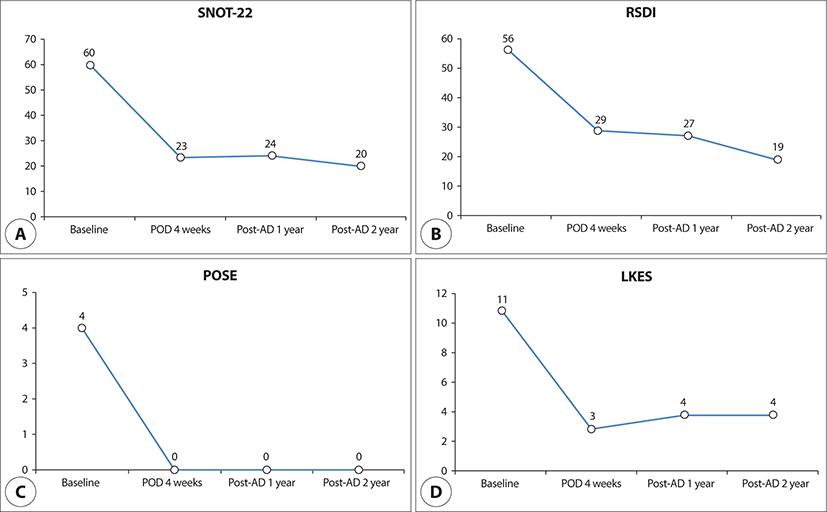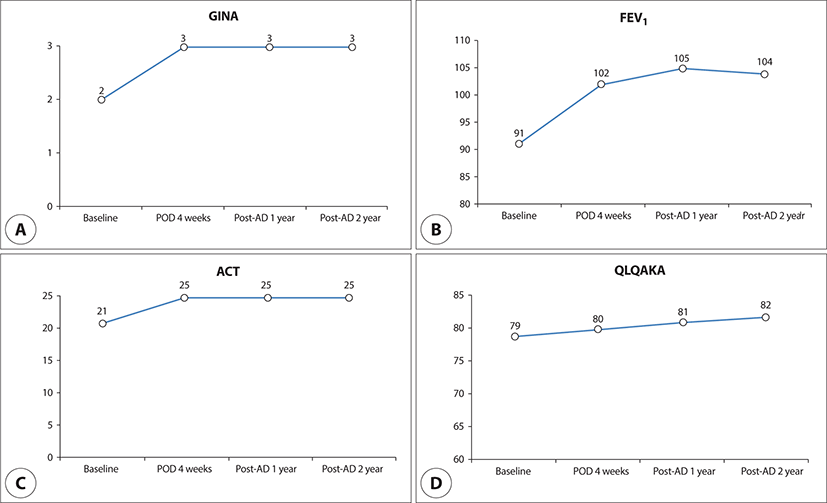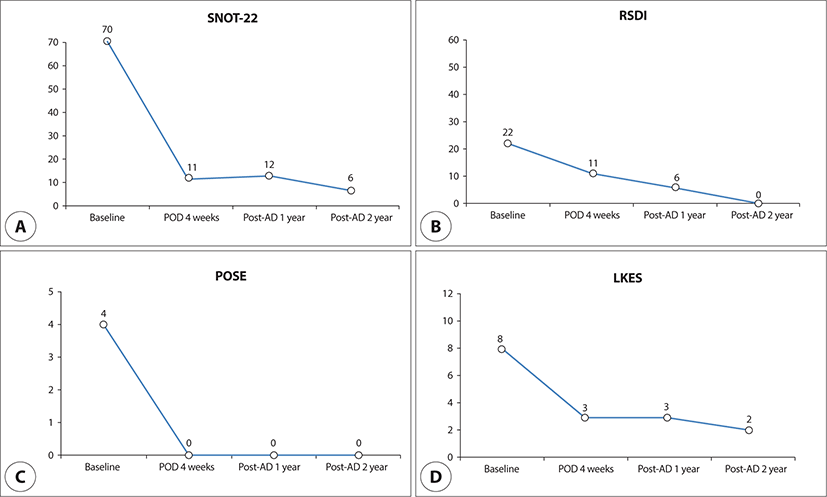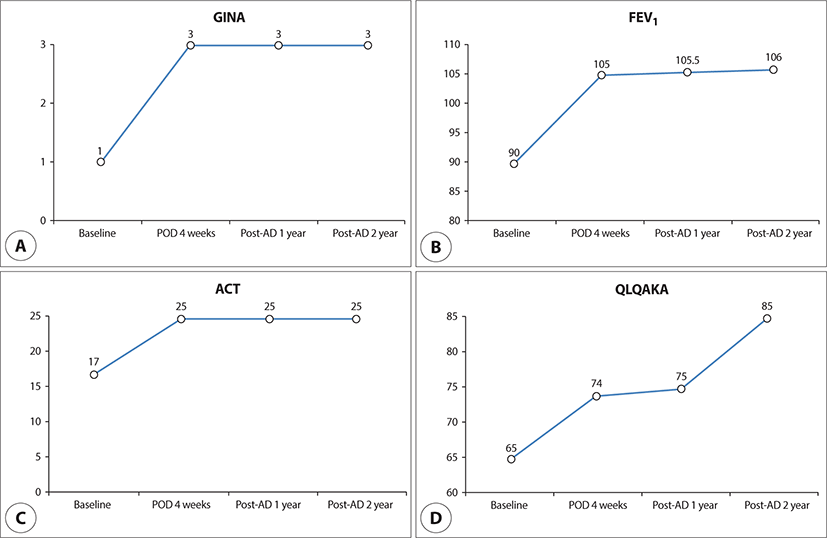Introduction
Chronic rhinosinusitis is a heterogeneous disease and, beyond the division of with or without nasal polyps, a variety of phenotypes have been identified. Aspirin-exacerbated respiratory disease (AERD) represents a particularly recalcitrant variant of chronic rhinosinusitis with nasal polyps accompanied by asthma and aspirin intolerance.1) Due to the large burden of nasal polyps, endoscopic sinus surgery (ESS) is usually performed to improve symptoms and to promote steroid delivery.2) However, AERD is notorious for being recalcitrant and patients often need revision surgery. Therefore, it is ideal for patients with AERD to receive additional medical treatment following ESS to prevent recurrence of chronic rhinosinusitis with nasal polyps.3) We report two cases of improved outcomes of sinonasal status and asthma control after aspirin desensitization following ESS in AERD.
Case Reports
A 27-year-old male was referred to otorhinolaryngology department because of nasal obstruction and anosmia from internal medicine. He had undergone prior ESS 6 years and 2 years ago. The patient’s medical history was otherwise unremarkable. The bronchial challenges with L-lysine aspirin showed a 25% decrease in the forced expiratory volume in one second (FEV1) at 300 mg/mL, which is acceptable to diagnosis with AERD. Revision ESS was performed under general anesthesia. Four weeks following ESS, oral aspirin challenge and desensitization were performed. Patients began with a 25 mg oral aspirin, followed by escalating doses of aspirin progressing through 50 mg, 100 mg, 150 mg, and 300 mg, administrated at 90 minutes intervals under intensive monitoring. The maintenance dose is 500 mg twice daily for one month, followed by 500 mg daily. Nasal symptom scores assessed by the Sinonasal Outcomes Test-22 (SNOT-22) and Rhino-Sinusitis Disability Index (RSDI) were improved at 4 weeks post-surgery and further decreased at 2 years post-desensitization (Fig. 1A, B). Furthermore, preoperative endoscopic polyp scores and Lund-Kennedy (LK) endoscopic scores were decreased and sustained post-desensitization throughout the follow-up period (Fig. 1C, D). Level of asthma symptom control was improved from partly controlled status preoperatively to well controlled status at 4 weeks post-surgery and 2 years post-desensitization according to the Global Initiative for Asthma (GINA) guideline: 1=uncontrolled, 2=partly controlled, 3=well controlled (Fig. 2A). FEV1 increased from 91% to 104% at 2 years post-desensitization (Fig. 2B). The degree of asthma control by questionnaire using Asthma Control Test (ACT) and quality of life questionnaire for adult Korean asthmatics (QLQAKA) was improved post-surgery and remained at 2 years post-desensitization (Fig. 2C, D).


A 41-year-old woman with AERD presented posterior nasal drip and olfactory dysfunction two years ago. She had undergone nasal polypectomy due to nasal congestion and anosmia at a local clinic several times. Revision ESS was performed, which is followed by oral aspirin desensitization at 4 weeks post-surgery. Final maintenance doses of aspirin were 500 mg once a day. The SNOT-22 and RSDI scores decreased after surgery and further decreased at 2 years post-desensitization (Fig. 3A, B). Postoperative endoscopic polyp scores and LK scores decreased and continued to remain low at all time points throughout the follow-up period (Fig. 3C, D). Level of asthma symptom control based on the GINA guideline was improved to well controlled state at after 4 weeks post-surgery and 2 years post-desensitization (Fig. 4A). FEV1 and ACT scores remained increased at all time points throughout the follow-up period (Fig. 4B, C). The QLQAKA scores were improved at 4 weeks post-surgery and further increased at 2 years post-desensitization (Fig. 4D).


Discussion
AERD was first described in 1922 by Widal et al. as a triad of symptoms: asthma, nasal polyps, and aspirin intolerance.4) Although the exact mechanism remains unclear, AERD is thought to be a non-allergic hypersensitivity reaction associated with an abnormal metabolism of arachidonic acid.5) Many patients with AERD first visited the otorhinolaryngology department because nasal obstruction and anosmia are the most common symptoms of AERD. Furthermore, these patients usually have intractable chronic rhinosinusitis that requires multiple surgeries. The present cases describe the successful outcomes of sinonasal status and asthma control after post-ESS aspirin desensitization using an endoscopic scoring system and validated symptom questionnaires in AERD patients.
Aspirin sensitivity was determined by a patient’s history of dyspnea or asthma attacks after ingestion of aspirin or other nonsteroidal anti-inflammatory drug.6) However, the diagnosis of AERD could be confirmed only through the provocative aspirin challenge test by increasing doses of aspirin.7,8) Although oral challenges are the most commonly used and regarded as gold standard methods,8) bronchial challenges with L-lysine aspirin were used in this study because this provocation is safer and faster to perform than oral route.
AERD may be medically treated according to established guidelines for managing asthma and chronic rhinosinusitis. Management usually proceeds through the use of topical corticosteroids and leukotriene-modifier drugs. In addition, steroid irrigation, oral steroids, immunotherapy, and anti- immunoglobulin E treatment might be considered as adjuvant medical treatment in patients with AERD. Aspirin desensitization has been recognized as a useful adjunct to ESS in the treatment of AERD patients, but is currently poorly used treatment.9) Aspirin desensitization should be considered as a therapeutic option in patients requiring daily or frequent use of systemic corticosteroids to control asthma or rhinosinusitis symptoms, patients with aggressive nasal polyp formation requiring multiple ESS, and patients with other diseases or indications requiring use of aspirin or other COX-1 inhibitors.
Although ESS clears the burden of gross nasal polyps and improves severity of asthma, it does not address the underlying abnormal metabolism of arachidonic acid. It is ideal that patients with refractory chronic rhinosinusitis with nasal polyps should be treated by aspirin desensitization after ESS because aspirin desensitization is most effective in preventing or retarding the regrowth of nasal polyps in the paranasal sinuses that have been surgically cleared. Although the optimal dose of aspirin for maintenance therapy has not been known, it should be at least 325 mg once a day and ideally twice a day.10) To date, there has been no consensus on the initiation time and duration of aspirin desensitization therapy. In general, the starting point of aspirin desensitization was recommended 2-12 weeks after ESS,11) and it was actually performed between 3 and 6 weeks in several papers.9,12,13) The duration of dosing was reported differently for each study, which was generally consistent with the duration of follow up. In this study, aspirin desensitization by daily oral intake of aspirin was performed at a month post-surgery. The maintenance dose of aspirin was 500 mg twice a day for one month, followed by 500 mg daily.
Aspirin desensitization therapy should be administered with caution due to the possibility of acute reaction including anaphylaxis. In addition, chronic use of it has been associated with upper GI bleeding and indigestion, increasing the risk, especially in elderly patients taking corticosteroids.11) Recently, biologics have been proposed as an alternative treatment for refractory chronic rhinosinusitis with nasal polyps. However, the cost-effectiveness of it in the setting of AERD has been questioned. On the other hand, aspirin desensitization after ESS was shown to be an favorable strategy in terms of cost-utility analysis, requiring minimal incremental cost to avoid additional revision surgery due to persistent symptoms.14) Aspirin desensitization following ESS showed a sustained preservation of the postsurgical improvements for the duration of the follow-up period. Aspirin desensitization well controlled sinonasal and asthma symptom scores, reduced the degree of nasal polyps formation, and improved FEV1 scores and quality of life in patients with AERD at 24 months post-desensitization.
Conclusion
The AERD phenotype is known to be the most severe form of chronic rhinosinusitis showing higher rates of recurrence after ESS. Aspirin desensitization following ESS may reduce the recurrence rate of nasal polyps and help to maintain an improved sinonasal status and control asthmatic symptoms in patients with AERD.






